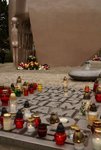In December 1942, a camp for Polish children and youth (Polenjugendverwahrlager der Sicherheitspolizei in Litzmannstadt) was established in a separate area within the confines of the ghetto, a section bordered roughly by what is today Bracka, Emilii Plater, Gornicza and Zagajnikowa streets. The main gate to the camp was located on Przemyslowa Street; hence, it was often referred to as "The Camp on Przemyslowa Street." The Main Security Office of the Reich on November 28, 1942, explained that it would be a camp for adolescent Poles, those deemed criminals or uncared-for, "who, therefore, are a dangerous element both for the German children, and because of the fact that they could continue their criminal activity." Appearances were fabricated to suggest it was an educational facility to rehabilitate juvenile offenders. In reality, it was a concentration camp for children and youth up to the age of 16. The young inmates had numbers instead of names, wore grey prison garbs and clogs, and worked from morning to night. They were routinely beaten, even flogged.
The camp area was surrounded by a high fence made up of planks and patrolled by German sentries.
The camp prisoners primarily came from the areas incorporated into the Reich and from the General Gouvernement. Some of them were taken from orphanages; some were those whose parents were killed or arrested for their involvement in the resistance movement. By January 1945, an estimated 1,600 Polish children went through this camp. The exact number of inmates is difficult to establish because many of the records are missing. When the war was over, there were about 900 prisoners in the camp.
The children worked just as their peers did in the ghetto, on the other side of a high wall. They even had the same teachers - the Jewish artisans, escorted there by the Nazi authorities. The children stitched clothes, made straw shoes, mended knapsacks and straightened out needles. Many of them died of starvation, cold and emaciation, especially during the typhus epidemic that broke out in late 1942 and early 1943. Records document 136 deaths. The children that fell ill were sent to the hospital at 74 Dworska St. (what is now Organizacji WiN Street) in the ghetto.
The Polish children in this camp were completely isolated from the outside world and had no contact with the people from the other side of the wall. A branch of this camp also operated on a private estate in Dzierzana, 15 kilometers from Lodz.
Today, only the old camp administrative building at 34 Przemyslowa St. remains. For many years after the war, people did not know about this camp for Polish children and youth. In May 1971, the Broken Heart Monument was unveiled in Szarych Szeregow Park (what was formerly called Promienistych Park), a somber reminder of the young victims. The monument, designed by Jadwiga Janus and Ludwik Mackiewicz, is located just outside the old camp area.
The camp area was surrounded by a high fence made up of planks and patrolled by German sentries.
The camp prisoners primarily came from the areas incorporated into the Reich and from the General Gouvernement. Some of them were taken from orphanages; some were those whose parents were killed or arrested for their involvement in the resistance movement. By January 1945, an estimated 1,600 Polish children went through this camp. The exact number of inmates is difficult to establish because many of the records are missing. When the war was over, there were about 900 prisoners in the camp.
The children worked just as their peers did in the ghetto, on the other side of a high wall. They even had the same teachers - the Jewish artisans, escorted there by the Nazi authorities. The children stitched clothes, made straw shoes, mended knapsacks and straightened out needles. Many of them died of starvation, cold and emaciation, especially during the typhus epidemic that broke out in late 1942 and early 1943. Records document 136 deaths. The children that fell ill were sent to the hospital at 74 Dworska St. (what is now Organizacji WiN Street) in the ghetto.
The Polish children in this camp were completely isolated from the outside world and had no contact with the people from the other side of the wall. A branch of this camp also operated on a private estate in Dzierzana, 15 kilometers from Lodz.
Today, only the old camp administrative building at 34 Przemyslowa St. remains. For many years after the war, people did not know about this camp for Polish children and youth. In May 1971, the Broken Heart Monument was unveiled in Szarych Szeregow Park (what was formerly called Promienistych Park), a somber reminder of the young victims. The monument, designed by Jadwiga Janus and Ludwik Mackiewicz, is located just outside the old camp area.

